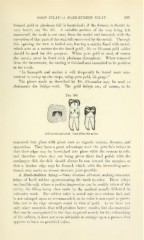Page 401 - My FlipBook
P. 401
GOLD INLAY—A HARD-RUBBER INLAY. 399
formed gold or platinum foil is burnished; if the former, it should be
very heavy, say No. 60. A suitable portion of the wax being left
uncovered, the work is cut away from the model and invested, with the
exception of that part of the wax left uncovered by the metal. Through
this opening the wax is boiled out, leaving a matrix lined with metal,
which acts as a carrier for the fused gold ; 20- or 22-carat gold solder
should be used for this purpose. When pure gold is used, of course
the matrix must be lined with platinum throughout. When removed
from the investment, the casting is finished and cemented to its position
in the tooth.
" In bicuspids and molars it will frequently be found more con-
venient to stamp up the cusps, using pure gold, 35 gauge."
The pieces made as described by Dr. Alexander may be used as
abutments for bridge-work. The gold inlays are, of course, to be
Fig. 389.
Foil matrix invested. Cast filling for molar.
cemented into place with great care as regards asepsis, dryness, and
apposition. They have a great advantage over the porcelain inlays in
that their edges may be burnished into place while the cement is soft;
and therefore when thev are being given their final polish with the
sandpaper disk the disk should always be run toward the margins, so
that a feather edge may be formed, which, with the burnishing men-
tioned, may make an almost absolute joint possible.
A Hard-Rubber Inlay.—Some dentists advocate making cemented
inlays of hard rubber approximating the tooth in color. These inlays
are feasible only where a perfect impression can be readily taken of the
cavity, the filling being then made by the method usually followed in
vulcanite work. The rubber inlay is noted only as a curious fact, and
is not enlarged upon or recommended, as its color is not equal to porce-
lain, nor is its edge strength equal to that of gold. As we have not
only other materials that will produce better results, but also materials
that can be manipulated in the time required merely for the vulcanizing
of the rubber, it does not seem advisable to enlarge upon a process that
appears to have no practical value.


